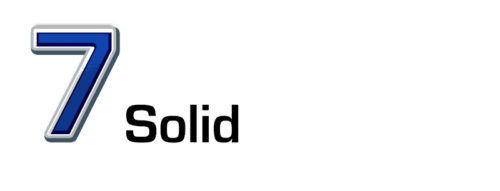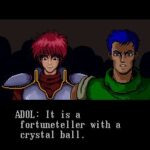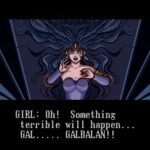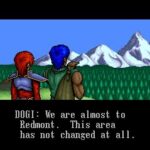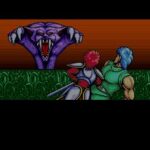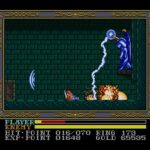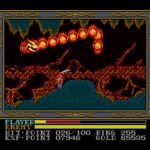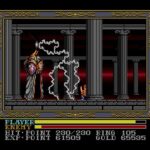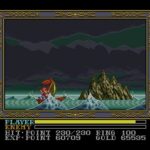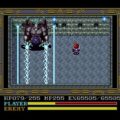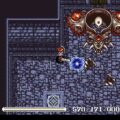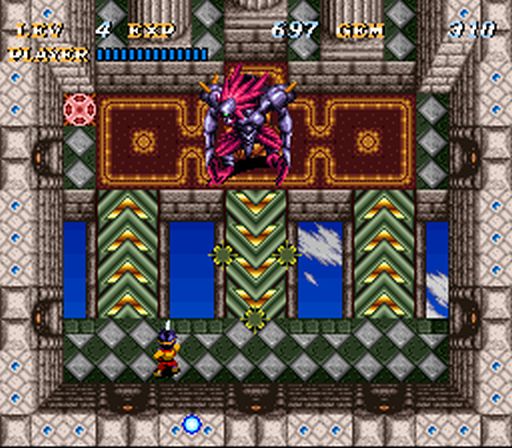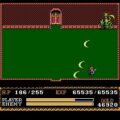Developer: Advance Communication Publisher: American Sammy Release: 01/92 Genre: Action RPG
Every long running franchise seems to have that one odd duck. Whether the designers want to something new or realized what they originally created simply was not good, it’s happened repeatedly in the land of video games. Simon’s Quest is one of the most popular examples along with Super Mario Brothers 2 but that is a whole other can of worms I will not get into. While it was usually the second game in the series that seemed to suffer this fate Ys III happens to be Falcom’s mid-life crisis.
After the events of Ys Book I & II Adol and Dogi continue their adventures and stumble on a fortune teller. Dogi has his fortune read only to have the crystal ball explode, a bad omen that prompts the pair to travel to his hometown. Upon arrival it seems the townspeople are under siege on multiple fronts. With no other jobs on the agenda the pair decide to help out.
Ys I & II are beloved classics for anyone who has been lucky enough to sample them. As a series Ys is on nearly every format imaginable. However the long standing curse of the series was that only the versions on failing platforms would reach the West. Ys III bucks that trend with versions on the SNES, Genesis, and Turbo Grafx CD hitting the US from different publishers. While there are differences between all 3 the base game is the same and one that fans would find divisive. The change in view allowed Falcom to tackle the biggest criticism of the series. But it also lost something else in the process, creating a solid but flawed adventure.
The biggest change comes in the form of the viewpoint. Ys III is a side-scroller and it affects all aspects of the game, most importantly combat. Let’s be honest, as much as we like Ys it was for the music and cut scenes and not the moment to moment action. With its overhead view Ys might as well have been a football RPG with Adol playing a linebacker. The attack method of ramming into enemies from the side is one of the most aggravating and least satisfying in existence and thankfully Ys III does away with that.
Like Zelda 2 you can swing your sword in nearly all directions which is very effective. The Ys games always have grinding so at least it is no longer a pain in the ass. Magic no longer exists and is instead replaced by 5 rings with different effects, such as healing or slowing time. The rings use energy that only replenishes in town or by killing enemies. Aside from those two changes the gameplay is more or less the same.
Despite what it gained in playability Ys III suffers from boring level design. As a consequence of the viewpoint the dungeons are mostly straightforward with the occasional branch here and there. It can be a bit challenging due to necessary grinding and the price of items. This version has spotty hit detection that makes the game harder. The boss battles are especially frustrating due to their insane damage; seriously you can die in seconds! At least being able to save anywhere helps.
There are noticeable differences between all 3 16-bit editions. The Turbo CD game has an absolutely amazing soundtrack that is on par with Ys Book I & II and is nearly worth the price of admission alone. The voice acting throughout the game is largely average but there isn’t much of it. The graphics are the weakest of the 3; while it’s more colorful than the Genesis version the parallax scrolling is jerky. This version is also the easiest; everything toned down a notch to avoid frustration but it makes the game a cakewalk. Since the game is so short the ease of this version will leave you unsatisfied.
The Genesis version has the darkest graphics of the bunch but strangely it works in its favor. The resolution of the SNES game is noticeably lower than the other two, creating a squished appearance that’s off putting. The color palette is also very muted which is uncharacteristic for the system. The music comes down to personal preference. I am not the biggest fan of the Genesis sound but composer Noriyuki Iwadare works wonders with the hardware. The SNES music is good but the quality is notably lower than its counterparts. The SNES version is the hardest due to bad enemy scaling whereas the Genesis version is the most balanced of the 3.
In Closing
Personally I would go with the Genesis game but any of the 16-bit versions Ys III is a good choice. Ys III was an interesting experiment but there is a reason the series went back to the top down view. Regardless of its critical reception it is still worth playing in my opinion. Without Ys III we would not have the foundation for its excellent remake the Oath in Felghana, now available in English on steam.
